PGCE Mathematics: Abstract Algebra, Curriculum & Teaching
VerifiedAdded on 2023/06/04
|30
|4800
|231
Report
AI Summary
This PGCE Mathematics report investigates the role of abstract algebra within the secondary school curriculum, emphasizing its importance in developing mathematical literacy and problem-solving skills. It highlights the alignment with national curriculum objectives, ensuring students can apply algebraic solutions from their initial years. The report delves into effective teaching methodologies, including geometric approaches to bracket multiplication, catering to both instrumental and relational learners. Common student misconceptions regarding variables, expressions, and equation construction are identified and addressed. The assessment section uses word problems to evaluate conceptual understanding. The report also touches upon the tension between exam preparation and fostering a deeper understanding of mathematical concepts, advocating for a balanced approach that equips students with skills relevant to their future lives. Desklib offers similar solved assignments and past papers for students.
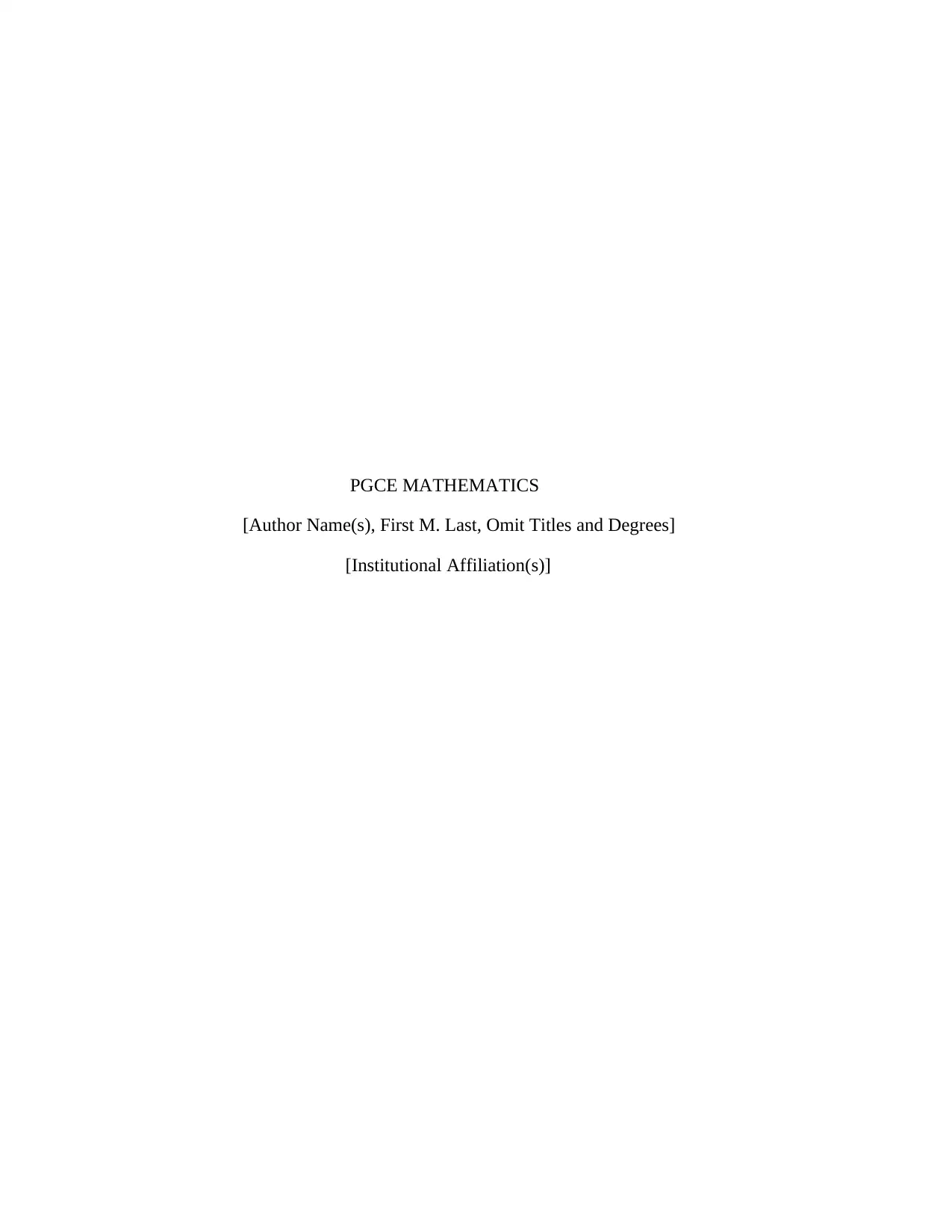
PGCE MATHEMATICS
[Author Name(s), First M. Last, Omit Titles and Degrees]
[Institutional Affiliation(s)]
[Author Name(s), First M. Last, Omit Titles and Degrees]
[Institutional Affiliation(s)]
Paraphrase This Document
Need a fresh take? Get an instant paraphrase of this document with our AI Paraphraser
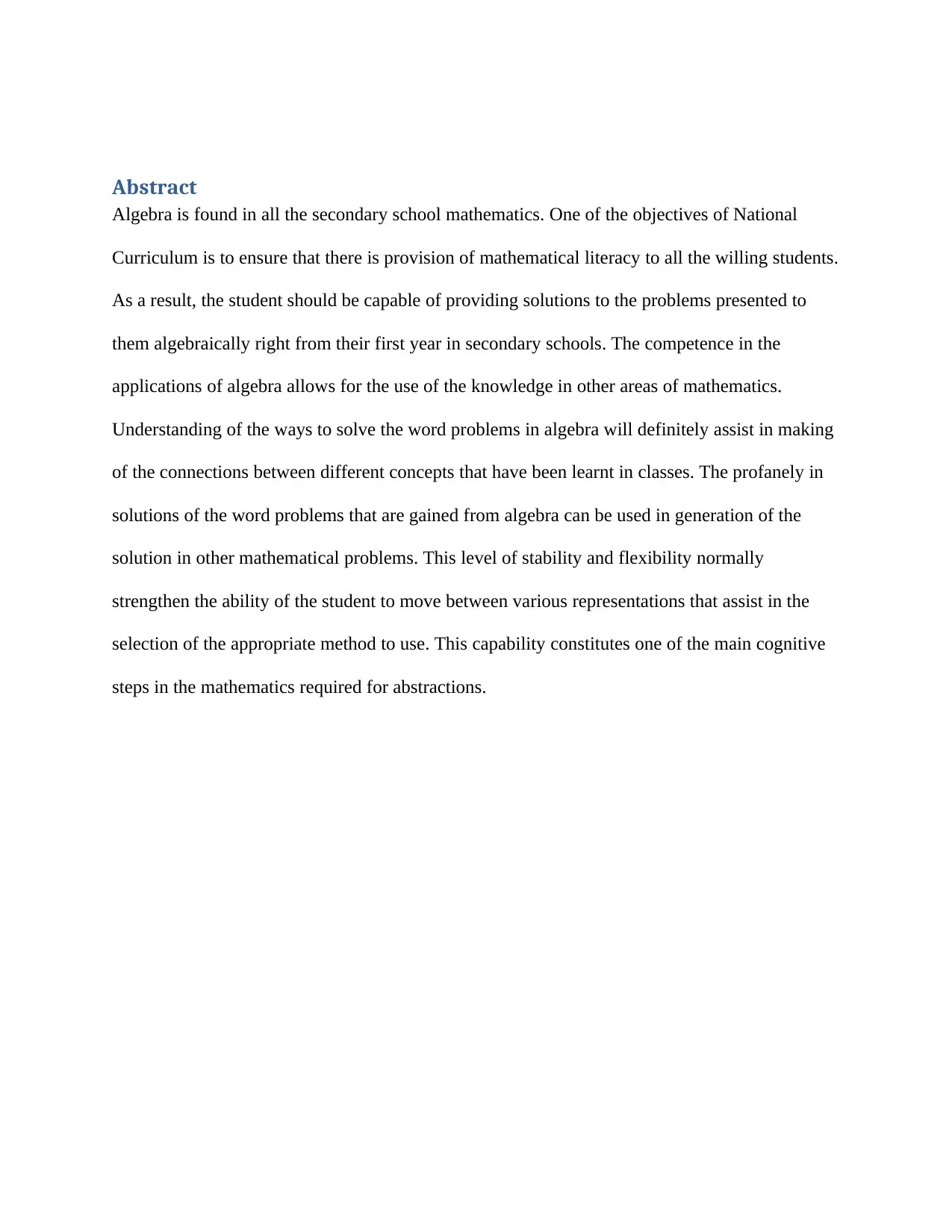
Abstract
Algebra is found in all the secondary school mathematics. One of the objectives of National
Curriculum is to ensure that there is provision of mathematical literacy to all the willing students.
As a result, the student should be capable of providing solutions to the problems presented to
them algebraically right from their first year in secondary schools. The competence in the
applications of algebra allows for the use of the knowledge in other areas of mathematics.
Understanding of the ways to solve the word problems in algebra will definitely assist in making
of the connections between different concepts that have been learnt in classes. The profanely in
solutions of the word problems that are gained from algebra can be used in generation of the
solution in other mathematical problems. This level of stability and flexibility normally
strengthen the ability of the student to move between various representations that assist in the
selection of the appropriate method to use. This capability constitutes one of the main cognitive
steps in the mathematics required for abstractions.
Algebra is found in all the secondary school mathematics. One of the objectives of National
Curriculum is to ensure that there is provision of mathematical literacy to all the willing students.
As a result, the student should be capable of providing solutions to the problems presented to
them algebraically right from their first year in secondary schools. The competence in the
applications of algebra allows for the use of the knowledge in other areas of mathematics.
Understanding of the ways to solve the word problems in algebra will definitely assist in making
of the connections between different concepts that have been learnt in classes. The profanely in
solutions of the word problems that are gained from algebra can be used in generation of the
solution in other mathematical problems. This level of stability and flexibility normally
strengthen the ability of the student to move between various representations that assist in the
selection of the appropriate method to use. This capability constitutes one of the main cognitive
steps in the mathematics required for abstractions.
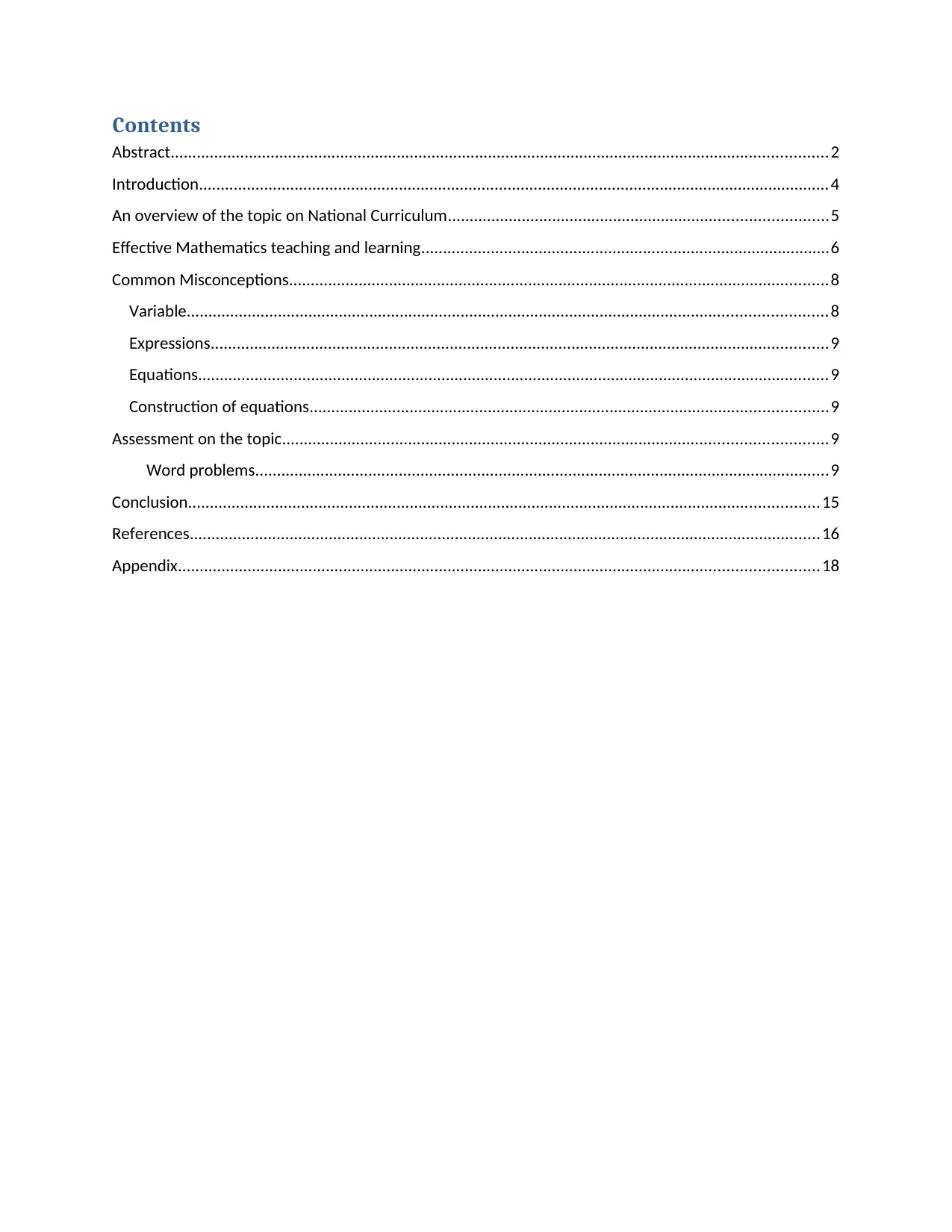
Contents
Abstract.......................................................................................................................................................2
Introduction.................................................................................................................................................4
An overview of the topic on National Curriculum.......................................................................................5
Effective Mathematics teaching and learning..............................................................................................6
Common Misconceptions............................................................................................................................8
Variable...................................................................................................................................................8
Expressions..............................................................................................................................................9
Equations.................................................................................................................................................9
Construction of equations.......................................................................................................................9
Assessment on the topic.............................................................................................................................9
Word problems....................................................................................................................................9
Conclusion.................................................................................................................................................15
References.................................................................................................................................................16
Appendix...................................................................................................................................................18
Abstract.......................................................................................................................................................2
Introduction.................................................................................................................................................4
An overview of the topic on National Curriculum.......................................................................................5
Effective Mathematics teaching and learning..............................................................................................6
Common Misconceptions............................................................................................................................8
Variable...................................................................................................................................................8
Expressions..............................................................................................................................................9
Equations.................................................................................................................................................9
Construction of equations.......................................................................................................................9
Assessment on the topic.............................................................................................................................9
Word problems....................................................................................................................................9
Conclusion.................................................................................................................................................15
References.................................................................................................................................................16
Appendix...................................................................................................................................................18
⊘ This is a preview!⊘
Do you want full access?
Subscribe today to unlock all pages.

Trusted by 1+ million students worldwide

Paraphrase This Document
Need a fresh take? Get an instant paraphrase of this document with our AI Paraphraser
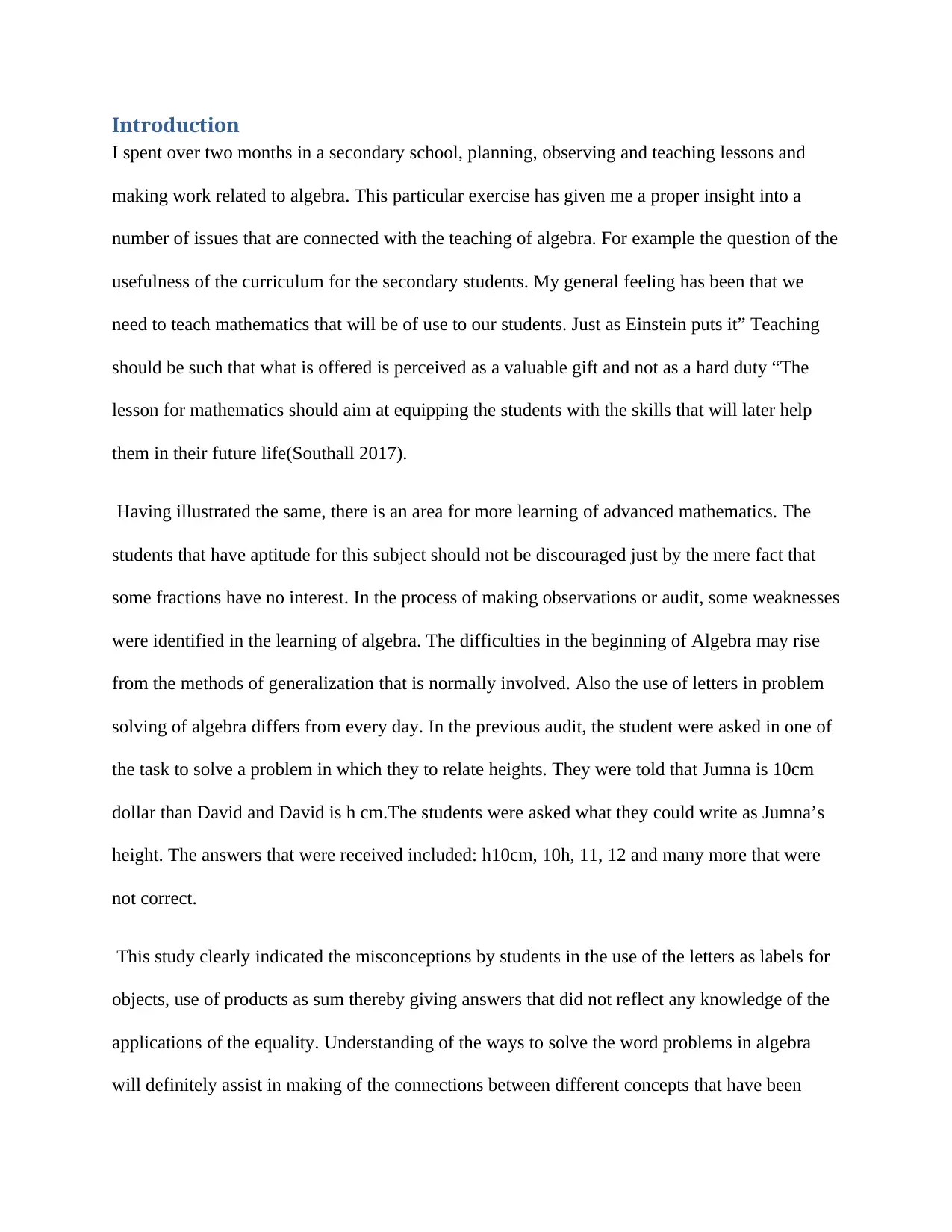
Introduction
I spent over two months in a secondary school, planning, observing and teaching lessons and
making work related to algebra. This particular exercise has given me a proper insight into a
number of issues that are connected with the teaching of algebra. For example the question of the
usefulness of the curriculum for the secondary students. My general feeling has been that we
need to teach mathematics that will be of use to our students. Just as Einstein puts it” Teaching
should be such that what is offered is perceived as a valuable gift and not as a hard duty “The
lesson for mathematics should aim at equipping the students with the skills that will later help
them in their future life(Southall 2017).
Having illustrated the same, there is an area for more learning of advanced mathematics. The
students that have aptitude for this subject should not be discouraged just by the mere fact that
some fractions have no interest. In the process of making observations or audit, some weaknesses
were identified in the learning of algebra. The difficulties in the beginning of Algebra may rise
from the methods of generalization that is normally involved. Also the use of letters in problem
solving of algebra differs from every day. In the previous audit, the student were asked in one of
the task to solve a problem in which they to relate heights. They were told that Jumna is 10cm
dollar than David and David is h cm.The students were asked what they could write as Jumna’s
height. The answers that were received included: h10cm, 10h, 11, 12 and many more that were
not correct.
This study clearly indicated the misconceptions by students in the use of the letters as labels for
objects, use of products as sum thereby giving answers that did not reflect any knowledge of the
applications of the equality. Understanding of the ways to solve the word problems in algebra
will definitely assist in making of the connections between different concepts that have been
I spent over two months in a secondary school, planning, observing and teaching lessons and
making work related to algebra. This particular exercise has given me a proper insight into a
number of issues that are connected with the teaching of algebra. For example the question of the
usefulness of the curriculum for the secondary students. My general feeling has been that we
need to teach mathematics that will be of use to our students. Just as Einstein puts it” Teaching
should be such that what is offered is perceived as a valuable gift and not as a hard duty “The
lesson for mathematics should aim at equipping the students with the skills that will later help
them in their future life(Southall 2017).
Having illustrated the same, there is an area for more learning of advanced mathematics. The
students that have aptitude for this subject should not be discouraged just by the mere fact that
some fractions have no interest. In the process of making observations or audit, some weaknesses
were identified in the learning of algebra. The difficulties in the beginning of Algebra may rise
from the methods of generalization that is normally involved. Also the use of letters in problem
solving of algebra differs from every day. In the previous audit, the student were asked in one of
the task to solve a problem in which they to relate heights. They were told that Jumna is 10cm
dollar than David and David is h cm.The students were asked what they could write as Jumna’s
height. The answers that were received included: h10cm, 10h, 11, 12 and many more that were
not correct.
This study clearly indicated the misconceptions by students in the use of the letters as labels for
objects, use of products as sum thereby giving answers that did not reflect any knowledge of the
applications of the equality. Understanding of the ways to solve the word problems in algebra
will definitely assist in making of the connections between different concepts that have been
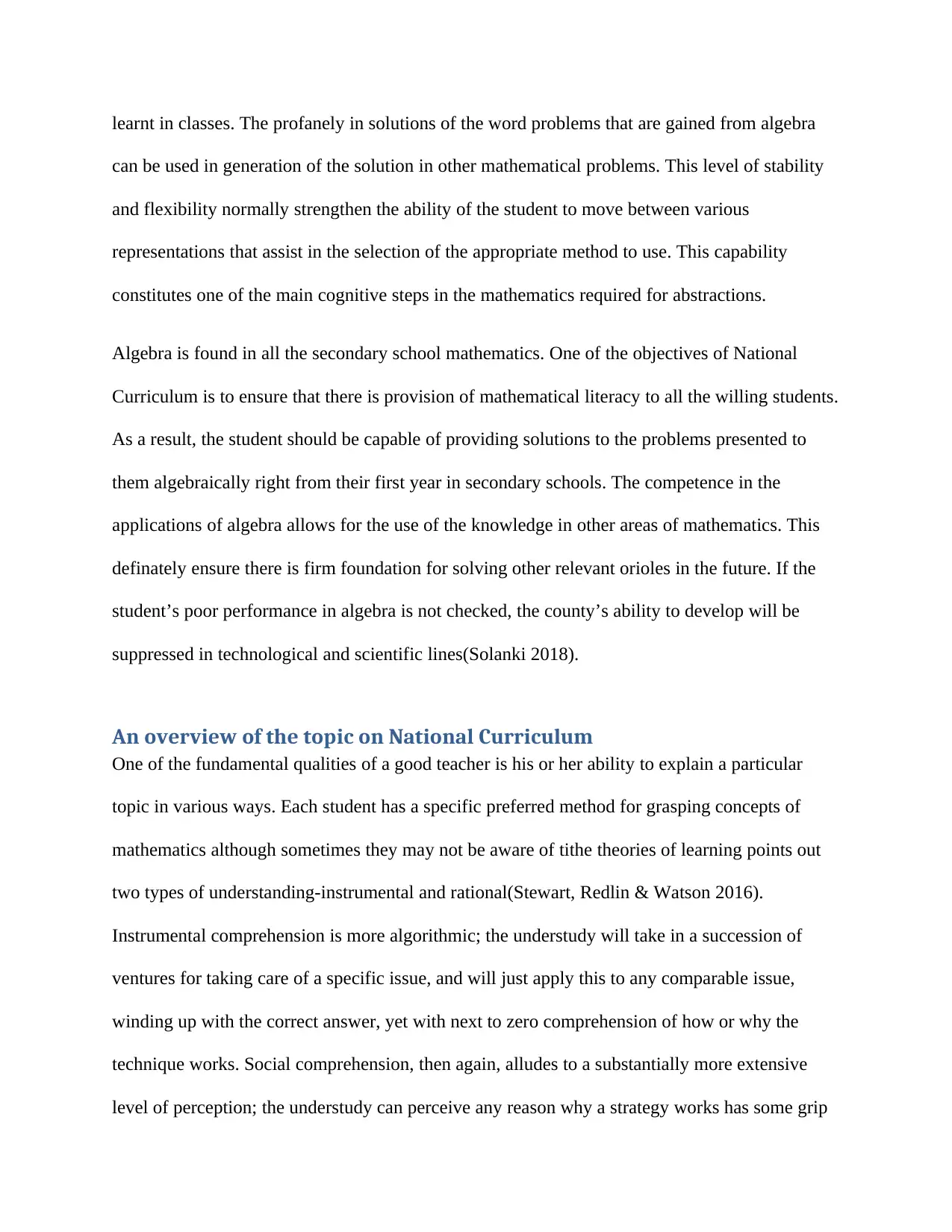
learnt in classes. The profanely in solutions of the word problems that are gained from algebra
can be used in generation of the solution in other mathematical problems. This level of stability
and flexibility normally strengthen the ability of the student to move between various
representations that assist in the selection of the appropriate method to use. This capability
constitutes one of the main cognitive steps in the mathematics required for abstractions.
Algebra is found in all the secondary school mathematics. One of the objectives of National
Curriculum is to ensure that there is provision of mathematical literacy to all the willing students.
As a result, the student should be capable of providing solutions to the problems presented to
them algebraically right from their first year in secondary schools. The competence in the
applications of algebra allows for the use of the knowledge in other areas of mathematics. This
definately ensure there is firm foundation for solving other relevant orioles in the future. If the
student’s poor performance in algebra is not checked, the county’s ability to develop will be
suppressed in technological and scientific lines(Solanki 2018).
An overview of the topic on National Curriculum
One of the fundamental qualities of a good teacher is his or her ability to explain a particular
topic in various ways. Each student has a specific preferred method for grasping concepts of
mathematics although sometimes they may not be aware of tithe theories of learning points out
two types of understanding-instrumental and rational(Stewart, Redlin & Watson 2016).
Instrumental comprehension is more algorithmic; the understudy will take in a succession of
ventures for taking care of a specific issue, and will just apply this to any comparable issue,
winding up with the correct answer, yet with next to zero comprehension of how or why the
technique works. Social comprehension, then again, alludes to a substantially more extensive
level of perception; the understudy can perceive any reason why a strategy works has some grip
can be used in generation of the solution in other mathematical problems. This level of stability
and flexibility normally strengthen the ability of the student to move between various
representations that assist in the selection of the appropriate method to use. This capability
constitutes one of the main cognitive steps in the mathematics required for abstractions.
Algebra is found in all the secondary school mathematics. One of the objectives of National
Curriculum is to ensure that there is provision of mathematical literacy to all the willing students.
As a result, the student should be capable of providing solutions to the problems presented to
them algebraically right from their first year in secondary schools. The competence in the
applications of algebra allows for the use of the knowledge in other areas of mathematics. This
definately ensure there is firm foundation for solving other relevant orioles in the future. If the
student’s poor performance in algebra is not checked, the county’s ability to develop will be
suppressed in technological and scientific lines(Solanki 2018).
An overview of the topic on National Curriculum
One of the fundamental qualities of a good teacher is his or her ability to explain a particular
topic in various ways. Each student has a specific preferred method for grasping concepts of
mathematics although sometimes they may not be aware of tithe theories of learning points out
two types of understanding-instrumental and rational(Stewart, Redlin & Watson 2016).
Instrumental comprehension is more algorithmic; the understudy will take in a succession of
ventures for taking care of a specific issue, and will just apply this to any comparable issue,
winding up with the correct answer, yet with next to zero comprehension of how or why the
technique works. Social comprehension, then again, alludes to a substantially more extensive
level of perception; the understudy can perceive any reason why a strategy works has some grip
⊘ This is a preview!⊘
Do you want full access?
Subscribe today to unlock all pages.

Trusted by 1+ million students worldwide
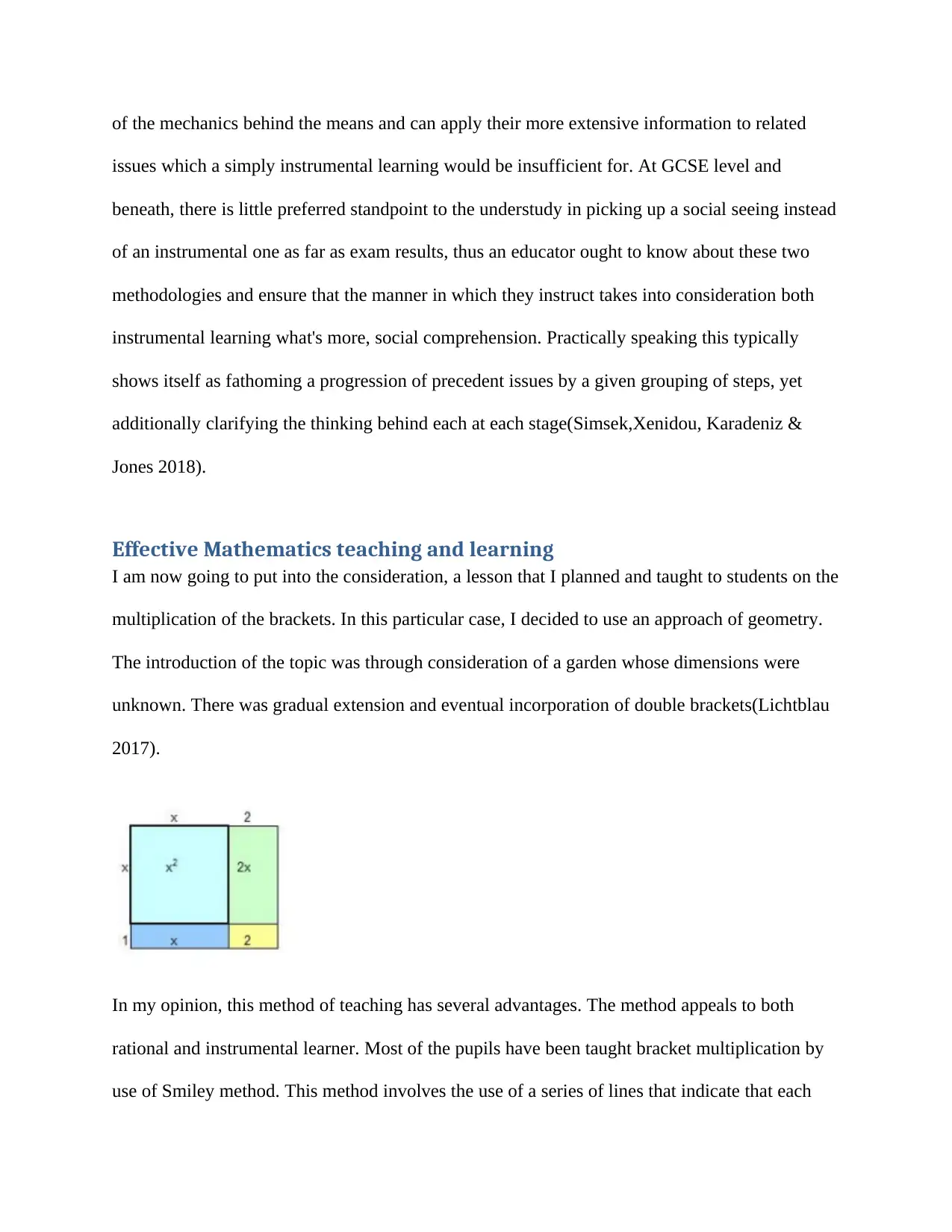
of the mechanics behind the means and can apply their more extensive information to related
issues which a simply instrumental learning would be insufficient for. At GCSE level and
beneath, there is little preferred standpoint to the understudy in picking up a social seeing instead
of an instrumental one as far as exam results, thus an educator ought to know about these two
methodologies and ensure that the manner in which they instruct takes into consideration both
instrumental learning what's more, social comprehension. Practically speaking this typically
shows itself as fathoming a progression of precedent issues by a given grouping of steps, yet
additionally clarifying the thinking behind each at each stage(Simsek,Xenidou, Karadeniz &
Jones 2018).
Effective Mathematics teaching and learning
I am now going to put into the consideration, a lesson that I planned and taught to students on the
multiplication of the brackets. In this particular case, I decided to use an approach of geometry.
The introduction of the topic was through consideration of a garden whose dimensions were
unknown. There was gradual extension and eventual incorporation of double brackets(Lichtblau
2017).
In my opinion, this method of teaching has several advantages. The method appeals to both
rational and instrumental learner. Most of the pupils have been taught bracket multiplication by
use of Smiley method. This method involves the use of a series of lines that indicate that each
issues which a simply instrumental learning would be insufficient for. At GCSE level and
beneath, there is little preferred standpoint to the understudy in picking up a social seeing instead
of an instrumental one as far as exam results, thus an educator ought to know about these two
methodologies and ensure that the manner in which they instruct takes into consideration both
instrumental learning what's more, social comprehension. Practically speaking this typically
shows itself as fathoming a progression of precedent issues by a given grouping of steps, yet
additionally clarifying the thinking behind each at each stage(Simsek,Xenidou, Karadeniz &
Jones 2018).
Effective Mathematics teaching and learning
I am now going to put into the consideration, a lesson that I planned and taught to students on the
multiplication of the brackets. In this particular case, I decided to use an approach of geometry.
The introduction of the topic was through consideration of a garden whose dimensions were
unknown. There was gradual extension and eventual incorporation of double brackets(Lichtblau
2017).
In my opinion, this method of teaching has several advantages. The method appeals to both
rational and instrumental learner. Most of the pupils have been taught bracket multiplication by
use of Smiley method. This method involves the use of a series of lines that indicate that each
Paraphrase This Document
Need a fresh take? Get an instant paraphrase of this document with our AI Paraphraser

term in the first bracket must be multiplied by the second term. Although this was equally
considered and results into the correct answer, there is little assistance to the student on
understanding of how it works and why. The use of the analogy between the multiplication and
calculation of area may bring an idea of square. This will possibly explain why a number
multiplied by it is called a square. The concept also explains the mixed terms(Pimm & Johnston
2016).
Majority of the students found this approach very useful to them despite the fact that it took them
longer to solve the first few problems. Considering that the topic was introduced in a similar
manner, it will hopefully mean that the topic will be understood and remembered better in the
future. This very concept can be extended to give illustration on why a negative-negative
multiplication results into the positive answer(Leahy & Wiliam 2015).
When there is removal of strip from the edge of the garden, it is simple to see that we are
actually subtracting to get the final area. Removal of the strip from the two sides gives the final
results
The students can follow with very little thought that removal of an entire strip from each side is
the same as removing the final part two times and therefore it needs to be added back at least
once. This type of explanation should help in the understanding of the students on the idea of
considered and results into the correct answer, there is little assistance to the student on
understanding of how it works and why. The use of the analogy between the multiplication and
calculation of area may bring an idea of square. This will possibly explain why a number
multiplied by it is called a square. The concept also explains the mixed terms(Pimm & Johnston
2016).
Majority of the students found this approach very useful to them despite the fact that it took them
longer to solve the first few problems. Considering that the topic was introduced in a similar
manner, it will hopefully mean that the topic will be understood and remembered better in the
future. This very concept can be extended to give illustration on why a negative-negative
multiplication results into the positive answer(Leahy & Wiliam 2015).
When there is removal of strip from the edge of the garden, it is simple to see that we are
actually subtracting to get the final area. Removal of the strip from the two sides gives the final
results
The students can follow with very little thought that removal of an entire strip from each side is
the same as removing the final part two times and therefore it needs to be added back at least
once. This type of explanation should help in the understanding of the students on the idea of
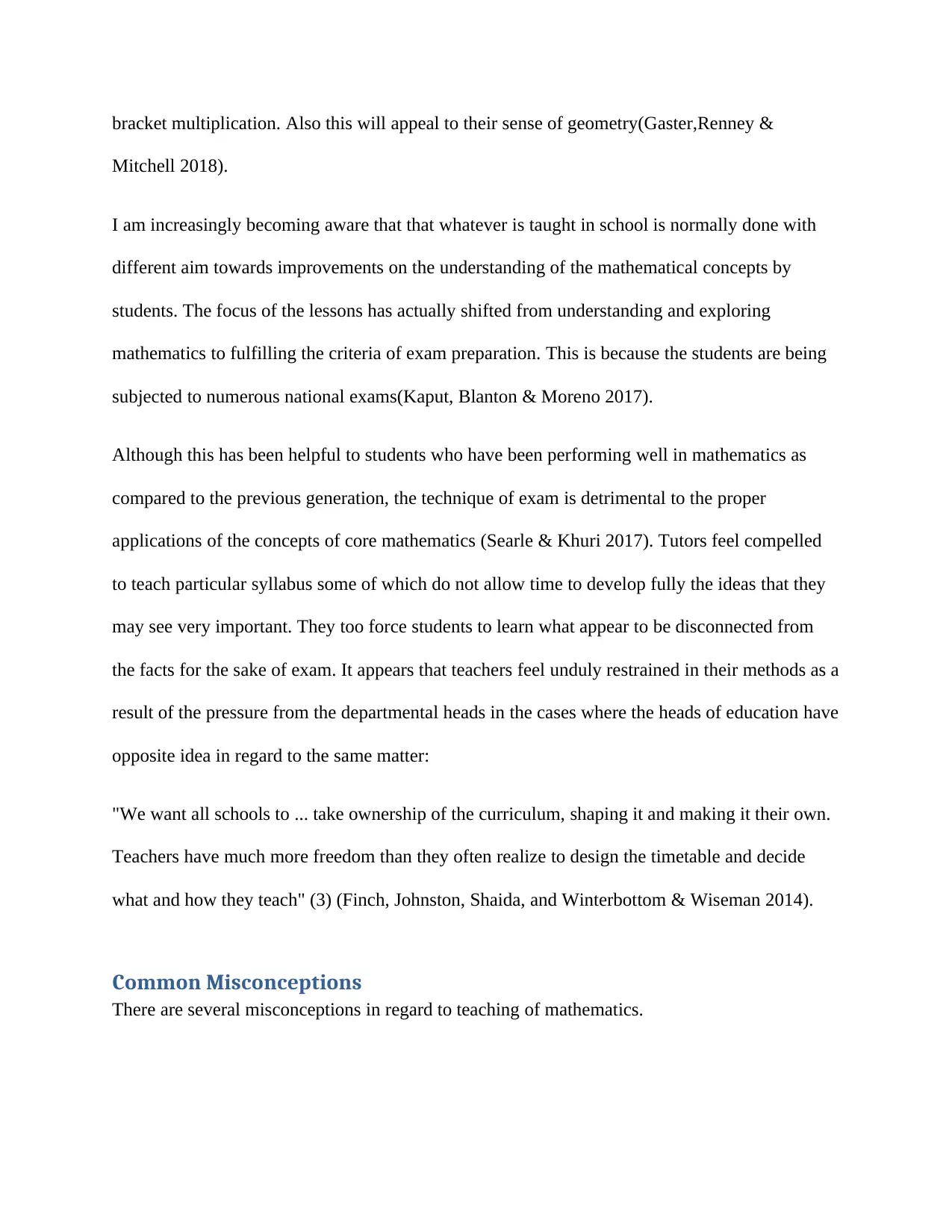
bracket multiplication. Also this will appeal to their sense of geometry(Gaster,Renney &
Mitchell 2018).
I am increasingly becoming aware that that whatever is taught in school is normally done with
different aim towards improvements on the understanding of the mathematical concepts by
students. The focus of the lessons has actually shifted from understanding and exploring
mathematics to fulfilling the criteria of exam preparation. This is because the students are being
subjected to numerous national exams(Kaput, Blanton & Moreno 2017).
Although this has been helpful to students who have been performing well in mathematics as
compared to the previous generation, the technique of exam is detrimental to the proper
applications of the concepts of core mathematics (Searle & Khuri 2017). Tutors feel compelled
to teach particular syllabus some of which do not allow time to develop fully the ideas that they
may see very important. They too force students to learn what appear to be disconnected from
the facts for the sake of exam. It appears that teachers feel unduly restrained in their methods as a
result of the pressure from the departmental heads in the cases where the heads of education have
opposite idea in regard to the same matter:
"We want all schools to ... take ownership of the curriculum, shaping it and making it their own.
Teachers have much more freedom than they often realize to design the timetable and decide
what and how they teach" (3) (Finch, Johnston, Shaida, and Winterbottom & Wiseman 2014).
Common Misconceptions
There are several misconceptions in regard to teaching of mathematics.
Mitchell 2018).
I am increasingly becoming aware that that whatever is taught in school is normally done with
different aim towards improvements on the understanding of the mathematical concepts by
students. The focus of the lessons has actually shifted from understanding and exploring
mathematics to fulfilling the criteria of exam preparation. This is because the students are being
subjected to numerous national exams(Kaput, Blanton & Moreno 2017).
Although this has been helpful to students who have been performing well in mathematics as
compared to the previous generation, the technique of exam is detrimental to the proper
applications of the concepts of core mathematics (Searle & Khuri 2017). Tutors feel compelled
to teach particular syllabus some of which do not allow time to develop fully the ideas that they
may see very important. They too force students to learn what appear to be disconnected from
the facts for the sake of exam. It appears that teachers feel unduly restrained in their methods as a
result of the pressure from the departmental heads in the cases where the heads of education have
opposite idea in regard to the same matter:
"We want all schools to ... take ownership of the curriculum, shaping it and making it their own.
Teachers have much more freedom than they often realize to design the timetable and decide
what and how they teach" (3) (Finch, Johnston, Shaida, and Winterbottom & Wiseman 2014).
Common Misconceptions
There are several misconceptions in regard to teaching of mathematics.
⊘ This is a preview!⊘
Do you want full access?
Subscribe today to unlock all pages.

Trusted by 1+ million students worldwide
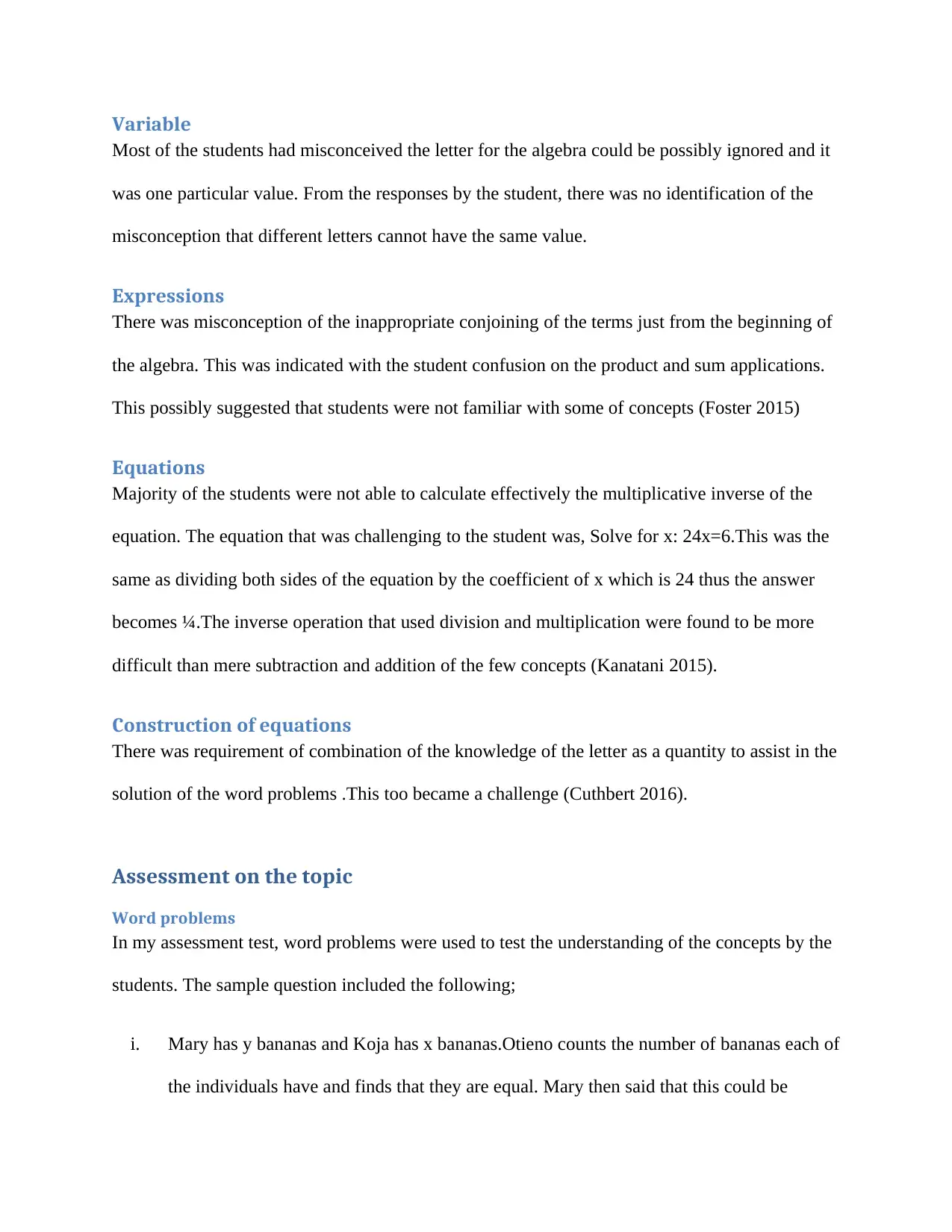
Variable
Most of the students had misconceived the letter for the algebra could be possibly ignored and it
was one particular value. From the responses by the student, there was no identification of the
misconception that different letters cannot have the same value.
Expressions
There was misconception of the inappropriate conjoining of the terms just from the beginning of
the algebra. This was indicated with the student confusion on the product and sum applications.
This possibly suggested that students were not familiar with some of concepts (Foster 2015)
Equations
Majority of the students were not able to calculate effectively the multiplicative inverse of the
equation. The equation that was challenging to the student was, Solve for x: 24x=6.This was the
same as dividing both sides of the equation by the coefficient of x which is 24 thus the answer
becomes ¼.The inverse operation that used division and multiplication were found to be more
difficult than mere subtraction and addition of the few concepts (Kanatani 2015).
Construction of equations
There was requirement of combination of the knowledge of the letter as a quantity to assist in the
solution of the word problems .This too became a challenge (Cuthbert 2016).
Assessment on the topic
Word problems
In my assessment test, word problems were used to test the understanding of the concepts by the
students. The sample question included the following;
i. Mary has y bananas and Koja has x bananas.Otieno counts the number of bananas each of
the individuals have and finds that they are equal. Mary then said that this could be
Most of the students had misconceived the letter for the algebra could be possibly ignored and it
was one particular value. From the responses by the student, there was no identification of the
misconception that different letters cannot have the same value.
Expressions
There was misconception of the inappropriate conjoining of the terms just from the beginning of
the algebra. This was indicated with the student confusion on the product and sum applications.
This possibly suggested that students were not familiar with some of concepts (Foster 2015)
Equations
Majority of the students were not able to calculate effectively the multiplicative inverse of the
equation. The equation that was challenging to the student was, Solve for x: 24x=6.This was the
same as dividing both sides of the equation by the coefficient of x which is 24 thus the answer
becomes ¼.The inverse operation that used division and multiplication were found to be more
difficult than mere subtraction and addition of the few concepts (Kanatani 2015).
Construction of equations
There was requirement of combination of the knowledge of the letter as a quantity to assist in the
solution of the word problems .This too became a challenge (Cuthbert 2016).
Assessment on the topic
Word problems
In my assessment test, word problems were used to test the understanding of the concepts by the
students. The sample question included the following;
i. Mary has y bananas and Koja has x bananas.Otieno counts the number of bananas each of
the individuals have and finds that they are equal. Mary then said that this could be
Paraphrase This Document
Need a fresh take? Get an instant paraphrase of this document with our AI Paraphraser
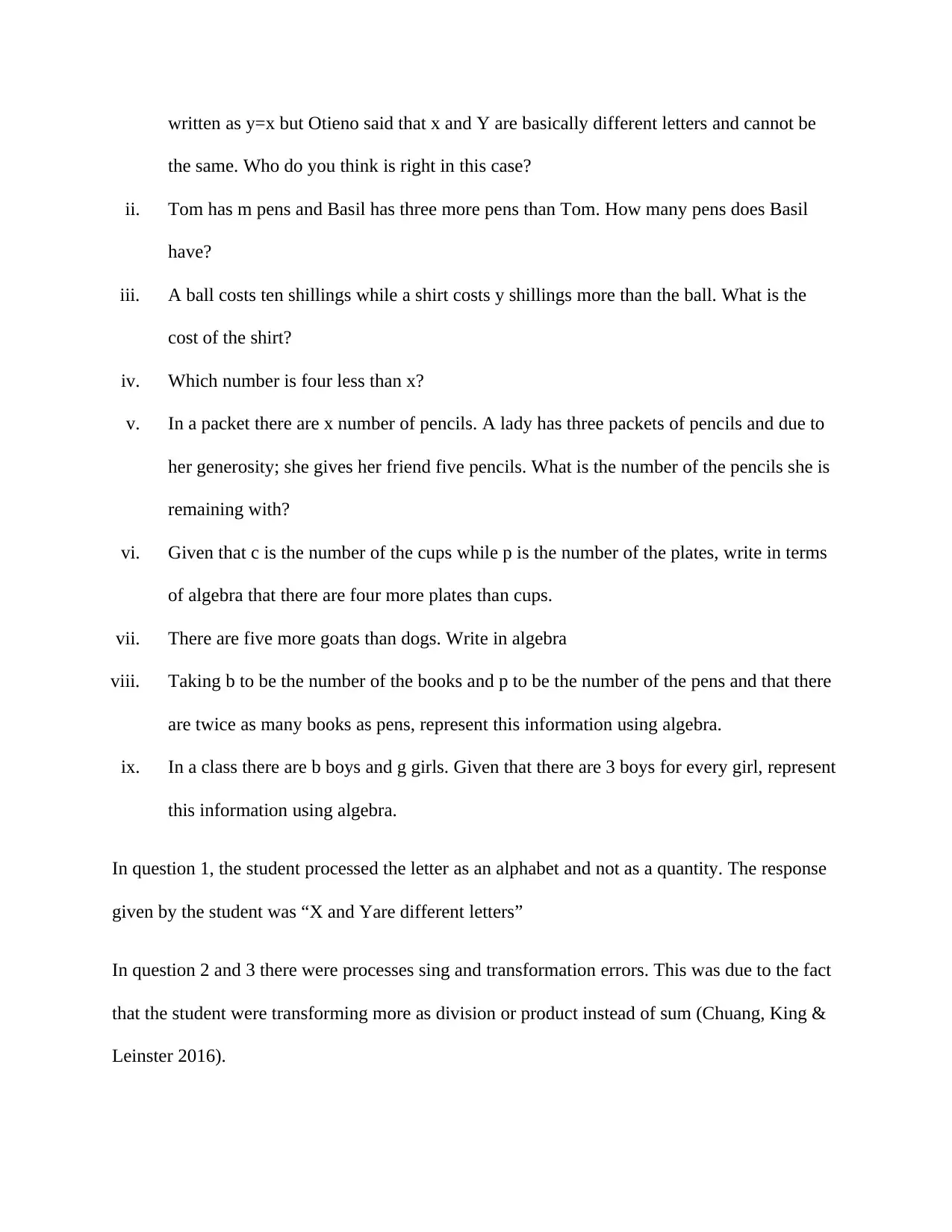
written as y=x but Otieno said that x and Y are basically different letters and cannot be
the same. Who do you think is right in this case?
ii. Tom has m pens and Basil has three more pens than Tom. How many pens does Basil
have?
iii. A ball costs ten shillings while a shirt costs y shillings more than the ball. What is the
cost of the shirt?
iv. Which number is four less than x?
v. In a packet there are x number of pencils. A lady has three packets of pencils and due to
her generosity; she gives her friend five pencils. What is the number of the pencils she is
remaining with?
vi. Given that c is the number of the cups while p is the number of the plates, write in terms
of algebra that there are four more plates than cups.
vii. There are five more goats than dogs. Write in algebra
viii. Taking b to be the number of the books and p to be the number of the pens and that there
are twice as many books as pens, represent this information using algebra.
ix. In a class there are b boys and g girls. Given that there are 3 boys for every girl, represent
this information using algebra.
In question 1, the student processed the letter as an alphabet and not as a quantity. The response
given by the student was “X and Yare different letters”
In question 2 and 3 there were processes sing and transformation errors. This was due to the fact
that the student were transforming more as division or product instead of sum (Chuang, King &
Leinster 2016).
the same. Who do you think is right in this case?
ii. Tom has m pens and Basil has three more pens than Tom. How many pens does Basil
have?
iii. A ball costs ten shillings while a shirt costs y shillings more than the ball. What is the
cost of the shirt?
iv. Which number is four less than x?
v. In a packet there are x number of pencils. A lady has three packets of pencils and due to
her generosity; she gives her friend five pencils. What is the number of the pencils she is
remaining with?
vi. Given that c is the number of the cups while p is the number of the plates, write in terms
of algebra that there are four more plates than cups.
vii. There are five more goats than dogs. Write in algebra
viii. Taking b to be the number of the books and p to be the number of the pens and that there
are twice as many books as pens, represent this information using algebra.
ix. In a class there are b boys and g girls. Given that there are 3 boys for every girl, represent
this information using algebra.
In question 1, the student processed the letter as an alphabet and not as a quantity. The response
given by the student was “X and Yare different letters”
In question 2 and 3 there were processes sing and transformation errors. This was due to the fact
that the student were transforming more as division or product instead of sum (Chuang, King &
Leinster 2016).
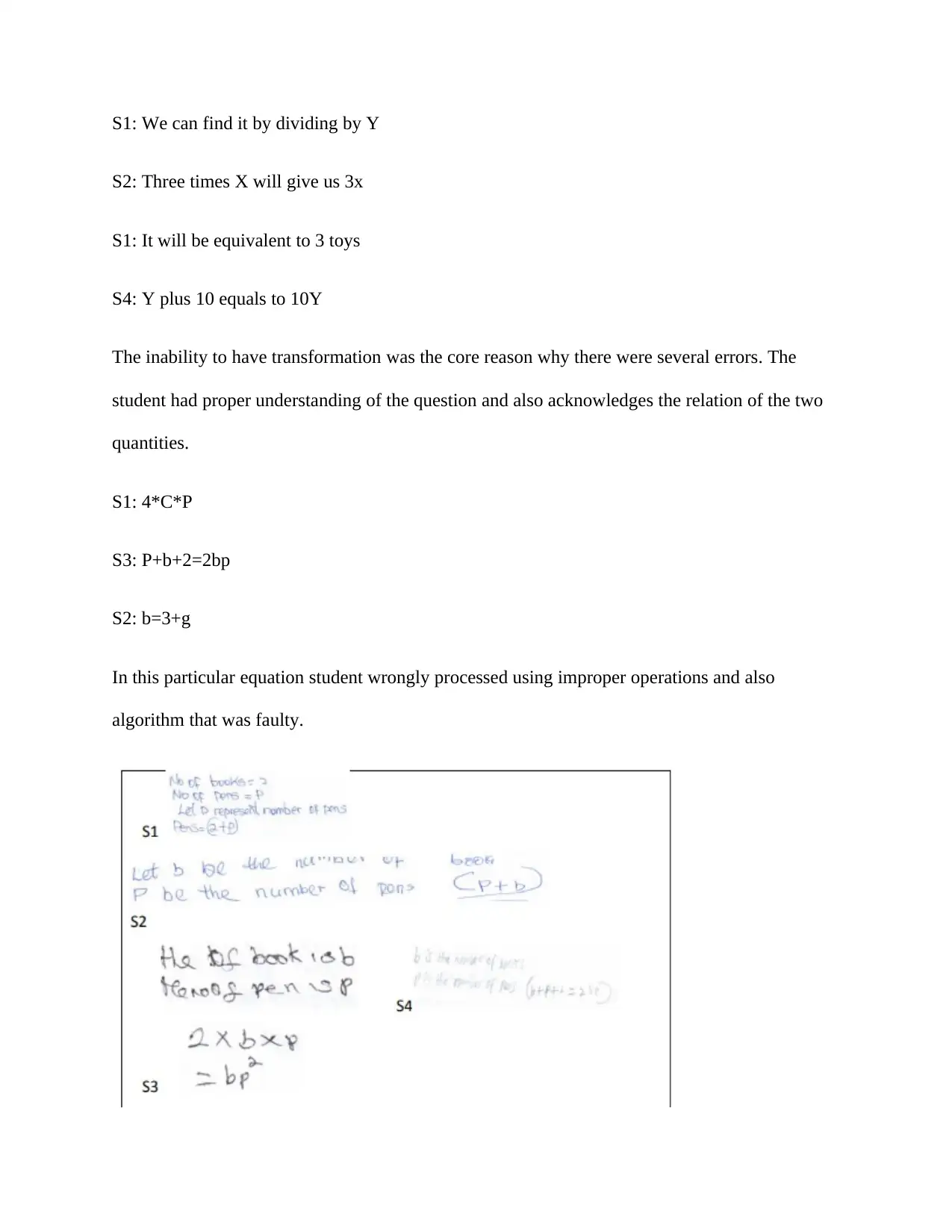
S1: We can find it by dividing by Y
S2: Three times X will give us 3x
S1: It will be equivalent to 3 toys
S4: Y plus 10 equals to 10Y
The inability to have transformation was the core reason why there were several errors. The
student had proper understanding of the question and also acknowledges the relation of the two
quantities.
S1: 4*C*P
S3: P+b+2=2bp
S2: b=3+g
In this particular equation student wrongly processed using improper operations and also
algorithm that was faulty.
S2: Three times X will give us 3x
S1: It will be equivalent to 3 toys
S4: Y plus 10 equals to 10Y
The inability to have transformation was the core reason why there were several errors. The
student had proper understanding of the question and also acknowledges the relation of the two
quantities.
S1: 4*C*P
S3: P+b+2=2bp
S2: b=3+g
In this particular equation student wrongly processed using improper operations and also
algorithm that was faulty.
⊘ This is a preview!⊘
Do you want full access?
Subscribe today to unlock all pages.

Trusted by 1+ million students worldwide
1 out of 30
Related Documents
Your All-in-One AI-Powered Toolkit for Academic Success.
+13062052269
info@desklib.com
Available 24*7 on WhatsApp / Email
![[object Object]](/_next/static/media/star-bottom.7253800d.svg)
Unlock your academic potential
Copyright © 2020–2025 A2Z Services. All Rights Reserved. Developed and managed by ZUCOL.





